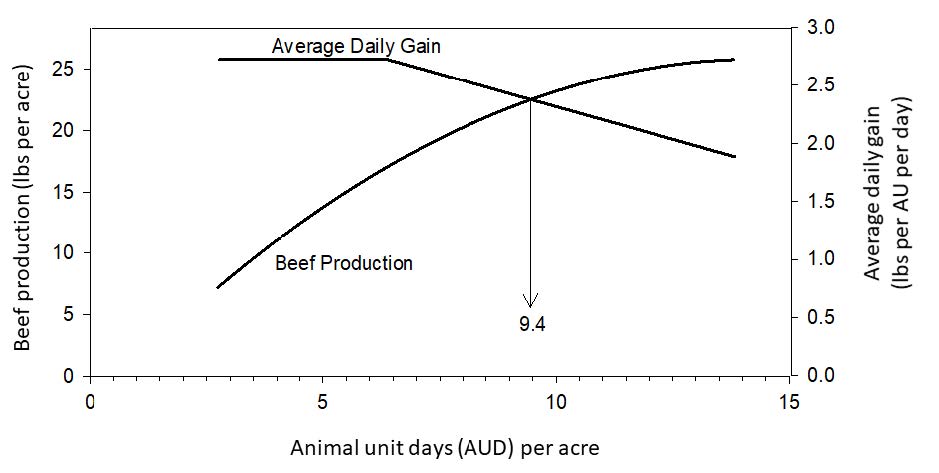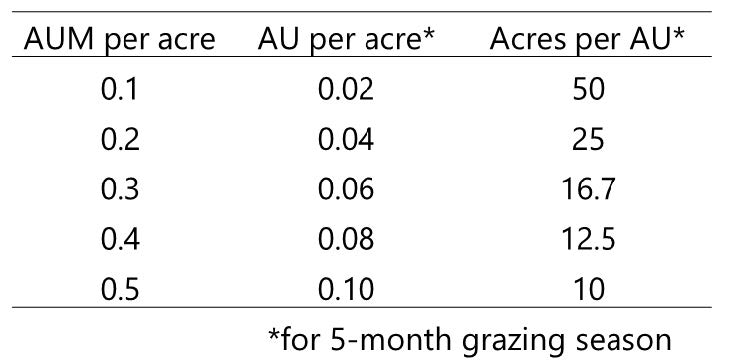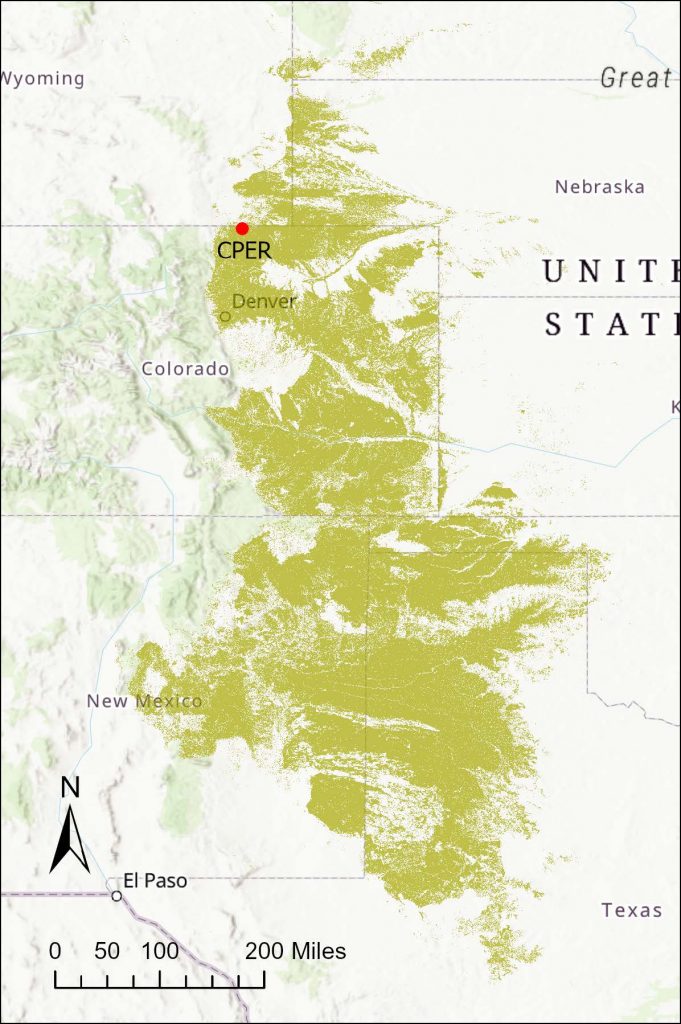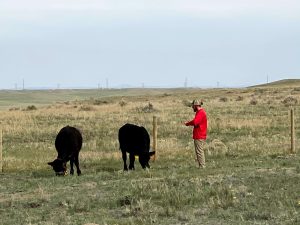by K. Jablonski, E. J. Raynor, D. Augustine, & J. Derner* (4/21)
Quick Facts…
- Researchers at the USDA-ARS recently found that the long-term sustainable stocking rate of the shortgrass steppe has increased by 72% in the last 50 years.
- The researchers attribute this to long-term changes in the plant community and improved livestock genetics.
- Though these findings are encouraging, managers in E. Colorado should be sure to place them in context with their own unique situations.
Definitions
- Animal Unit (AU) – one AU equals a 1,000 lb. cow with or without an unweaned calf, or the equivalent for animals of other sizes (e.g. 0.8 AU for an800 lb. steer)
- Animal unit month (AUM) – one AUM is one AU grazing for 30 days. It is a useful measure of forage consumption.
- Stocking rate – the total # of livestock on the total area of land to be grazed over time. Often reported as AUMs per acre or acres per AUM.
Setting Stocking Rate
Setting a stocking rate is one of the most important decisions that a livestock manager faces, both for their bottom line and the health of their land. Usually, managers and range scientists think of stocking rate in relation to forage production—how much forage is available, and how many animals can be stocked year after year without reducing production? Using rules of thumb such as “take half, leave half”, ranchers in different regions arrive at different long-term stocking rates (for example, 40 acres per cow-calf pair per grazing season). They then adjust this over time to match changing conditions.
A second approach focuses on cattle production rather than forage production and may be better suited to the highly variable climate of Eastern Colorado. Specifically, this outcome-oriented approach identifies the point where both individual animal performance and total beef production per acre are maximized over the long run.
Because it is based on data instead of rules of thumb and includes many years with varying rainfall and stocking rates, this approach ensures that animal productivity is not maximized at the expense of ecosystem health.
In these grazing-tolerant grasslands, if a stocking rate were to cause reductions in long-term forage production, it would show in a reduction in animal performance or beef production, or both.
Stocking Rate Research
Since 1939, researchers at the USDA Central Plains Experiment Range (CPER- see map on next page) have been studying grazing management and its effects on beef production and vegetation. With data from a long-term collaboration with local ranchers grazing British-breed yearlings on CPER land, they are in excellent position to assess how both animal production and ecosystem health can be optimized.
In 1969 and again in 2021, researchers at CPER used the cattle production method to estimate the long-term sustainable stocking rate on the shortgrass steppe. Integrating data from the 1940s through the early1960s, Bement (1969) estimated that the point at which both individual gains and total beef production were maximized was 0.18 AUM per acre. For a five-month grazing season, this would amount to 27.8 acres of land per animal unit (see conversion table).
Using data from 2000-2018, Raynor et al. (2021) used the same method to estimate the long-term sustainable stocking rate as 0.31 AUM per acre (9.4AUD per acre; see graph below). For a five-month grazing season, this would amount to 16.1 acres per animal unit. The different findings from 1969 and2021 indicate that the carrying capacity of the eastern Colorado shortgrass steppe has increased by72% in the last 50 years!
Why Did the Carrying Capacity Increase?
There are two likely explanations for this large increase in long-term sustainable stocking rate. First, CPER research has documented a shift from a plant community dominated by warm season blue grama (Bouteloua gracilis) to a more diverse community co-dominated by blue grama and cool season western wheatgrass (Pascopyrum smithii). This has been part of a fivefold increase in the cover of cool season perennial grasses, leading to a substantial increase in forage production. The CPER researchers attribute these plant community changes to long-term ecosystem recovery from the Dust Bowl, as well as changes in atmospheric carbon dioxide and nitrogen deposition, which lead to increased plant growth.
A second likely cause of the increased stocking rate is improved animal performance as a result of genetic improvements. High performing animals that gain weight more efficiently increase stocking rate by needing less forage to produce the same amount of weight gain.
CPER Location & Extent of Shortgrass Steppe

What Should Managers Do?
First, it is important to remember that these studies measured average long-term stocking rates, and so no rancher should take the findings to suggest that they should immediately increase their cattle herd. “Optimal” stocking rate must be placed in context with economic considerations as well as current short-term climatic and forage conditions(see Fact Sheet No. 3.115 about adjusting stocking rate based on climate forecasts). In addition, many ranchers may have already slowly adjusted their stocking rate upward over the years. Remember also that these results apply specifically to the shortgrass steppe, where grass species are very tolerant of grazing and can thus withstand heavier stocking.

Nevertheless, these compelling findings indicate that the grasslands of the shortgrass steppe have changed significantly in the last 70 years. They also remind ranchers and other land managers of the importance of monitoring and measuring the lands they manage. These findings are important and based in very solid research but, as always, it is important for ranchers to place the science in context with their own knowledge and data about their grazing land and animals.
Works cited:
- Bement ,R.E., 1969. A Stocking-Rate Guide for Beef Production on Blue-Grama Range.
- Journal of Range Management. https://repository.arizona.edu/handle/10150/649849
- Raynor, E.J., Derner, J.D., Baldwin, T., Ritten, J.P., Augustine, D.J., 2021. Multidecadal directional shift in shortgrass stocking rates. Rangeland Ecology &Management. https://www.ars.usda.gov/research/publications/publication/?seqNo115=374140
*Kevin Jablonski, Extension Range Ecologist, Dept. of Forest & Rangeland Stewardship, CSU; Edward J. Raynor, David Augustine, & Justin Derner, USDA Agricultural Research Service (ARS), Rangeland Resources & Systems Research Unit, Fort Collins, CO. 4/21.







